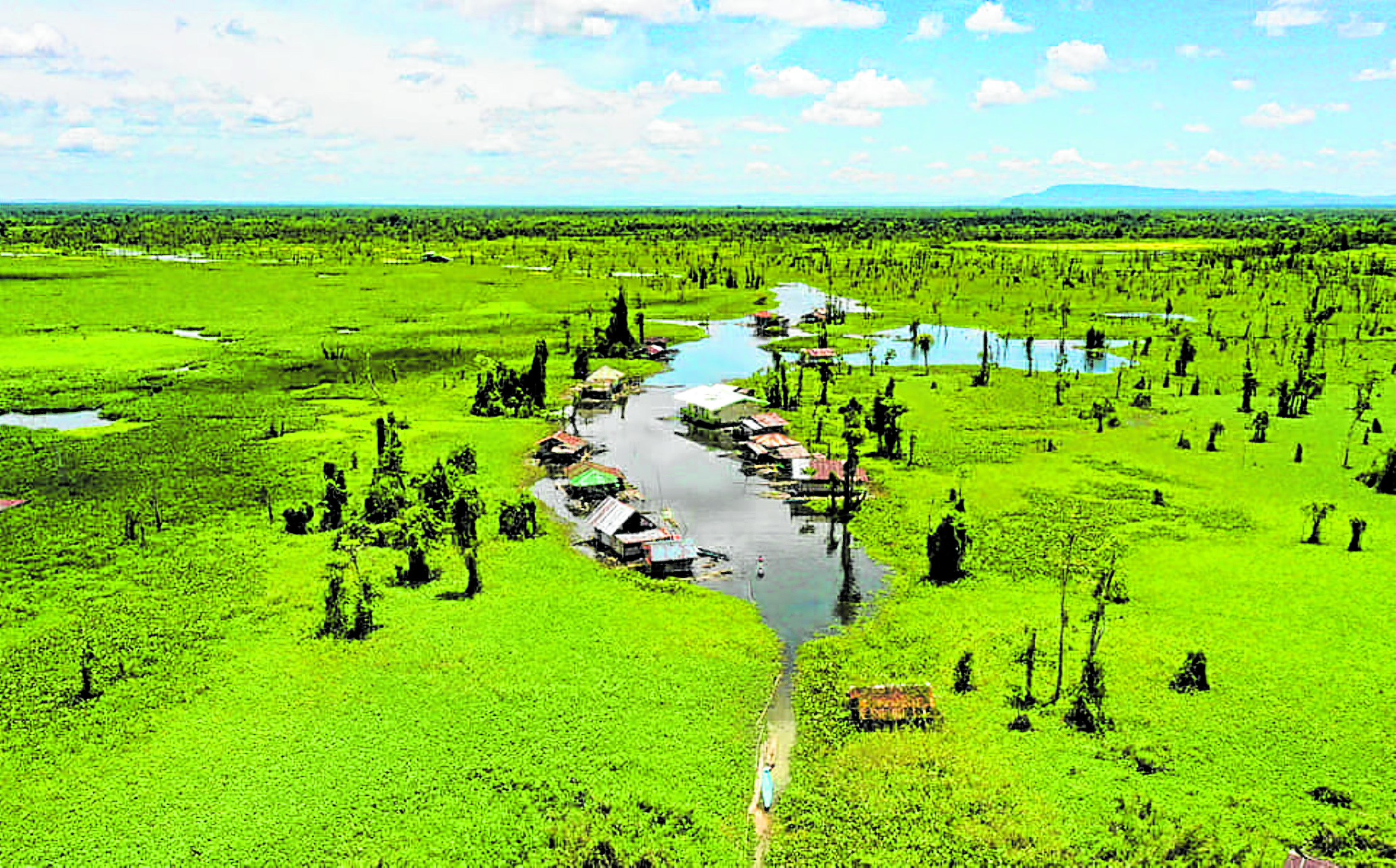DENR, mining firm join hands to develop access to Agusan Marsh

SANCTUARY The aerial view of Lake Panlabuhan, in this undated photo, shows the beauty of this wildlife sanctuary off the town of Loreto in Agusan del Sur. —PHOTO COURTESY OF THE AGUSAN MARSH WILDLIFE SANCTUARY-PROTECTED AREA MANAGEMENT OFFICE
BUNAWAN, AGUSAN DEL SUR — A collaborative effort between the government and a mining company is set to facilitate easier access to the globally acclaimed Agusan Marsh Wildlife Sanctuary (AMWS) located in Lake Panlabuhan, adjacent to the town of Loreto in Agusan del Sur province.
On Wednesday, a memorandum of agreement (MOA) was signed between the Department of Environment and Natural Resources (DENR) and Philsaga Mining Corp. (PMC) to revitalize the riverbank of Dagon Creek in Barangay Mambalili here, streamlining travel for tourists to the sanctuary to just 20 minutes by boat, compared to the longer route through Agusan River, which currently takes over an hour.
This project, funded by PMC with an initial cost of P624,000, will focus on rehabilitating the 9-kilometer banks on both sides of Dagon Creek through extensive tree plantation, using endemic tree species capable of withstanding flooding during heavy rains.
READ: Protection and wise use of our wetlands
The route from the AMWS-Protected Area Management Office Integrated Protected Area System Complex in Mambalili, where Dagon Creek is located, involves only a 4.5-km boat ride to reach Lake Panlabuhan, home to a Manobo community residing in 36 floating houses.
The primary objective of the project is to reforest brushland areas along the riverbank to mitigate siltation during periods of heavy flooding.
Nonito Tamayo, regional executive director of DENR Caraga, said that indigenous tree species such as bangkal, catmon, lanipao, and narra will be planted in a 10-meter wide strip on the riverbanks, reducing the distance to reach Panlabuhan Lake.
Tamayo assured that the rehabilitation funds provided by PMC will be allocated directly to the people’s organization called Kanimbaylan Bonkogon Lumad Agusan Marsh Loreto Organization (KBLAMLO), and disbursed per activity, until the project’s completion within a year.
Lumad partners
In his address prior to the MOA signing, PMC vice president Ferdinand Cortes emphasized the importance of diligent project implementation, expressing the company’s readiness to contribute additional funds for project enhancement.
“Let us not just confine on the MOA signing but to make it sure to realize the project,” Cortes said.
Responding to Cortes’ challenge, Remy “Datu Kanimbaylan” Reyes, chairman of KBLAMLO, expressed gratitude for the extensive planting activity along the Dagon Creek riverbanks.
“The (Manobo) tribe in our community have now realized the impact of climate change that the trees could protect us from strong winds and heavy floodings,” Reyes said in vernacular.
Significant wetland
Provincial Environment and Natural Resources Officer Norman Asugan explained that the project stemmed from PMC’s commitment to fund environmentally sustainable initiatives, a condition for obtaining an Environmental Clearance Certificate from the DENR.
“The project is simple but important in the long term. The objective is for people to appreciate the rich biodiversity of Agusan Marsh,” Asugan remarked
According to the DENR Agusan del Sur provincial office, AMWS stands out as one of the most ecologically significant wetlands in the country.
READ: Tales from my travels: From Basilan to the Spratlys
It encompasses unique habitats like the Sago and Peat Swamp Forest, providing refuge to rare and endangered species including the freshwater crocodile (Crocodylus mindorensis), saltwater crocodile (Crocodylus porosus), oriental darter (Anhinga melanogaster) and Philippine sailfin lizard (Hydrosaurus pustulatus).
AMWS serves as a crucial stopover for migratory birds in Asia, with over 15% of the nation’s freshwater resources stored within its boundaries. Its role as a natural “sponge” helps mitigate floods by absorbing excess water from heavy rainfall and rivers coursing through Agusan del Sur, Agusan del Norte and Compostela Valley, safeguarding downstream communities from catastrophic inundation.